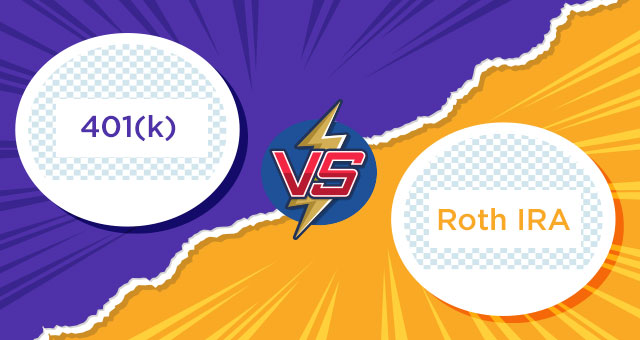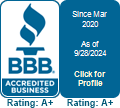
401(k) vs. Roth IRA: Pros & Cons
Even though retirement might seem far off, it is good to start saving as soon as possible to maximize your chances of success. Roth IRAs and 401(k) plans are popular ways to save for retirement. Both allow you to increase your savings with specific tax advantages, even if they differ in tax treatment, investment alternatives, and employer contributions.
Understanding what a 401(k) and a Roth IRA are and becoming aware of the benefits and drawbacks of each can make all the difference when it comes to making financial plans for the future.
A Roth IRA: What Is It?
A specific kind of Individual Retirement Account (IRA) offered in the USA is a Roth IRA. It stands out from other retirement investment plans as both account growth and withdrawals are tax-free.
The Basics of a Roth IRA
- A Roth IRA is established by the account owner through their preferred brokerage firm, and contributions are paid to the account after taxes.
- Investment gains are tax-free, and withdrawals made at or after age 59 ½ are typically tax-free.
- An employer does not make a matching contribution to a Roth IRA since it is an individual retirement account that the account holder established and maintains.
- You must fulfill certain income requirements to be able to contribute to a Roth IRA.
- A Roth IRA allows for many different forms of investments, including stocks, mutual funds, and bonds.
Here are a few benefits and drawbacks of a Roth IRA.
Pros Of A Roth IRA
1. Your Wealth Increases Tax-Free
As your Roth IRA contributions were made using post-tax money, you will not be taxed again when you take them out. And here’s the deal: The majority of the funds in your Roth IRA will be growth until you are ready to retire. Therefore, the fact that there are no taxes on that increase means that thousands of dollars stay in your pocket instead of Uncle Sam’s. However, you will have to pay taxes if you take a distribution of your income before you are 59 ½.
2. You Can Choose Your Investment Options
The benefit of a Roth IRA is that you can pick your investments. As you are not dependent on a third-party administrator’s decision on which funds you invest in, you can choose from several mutual funds, stocks, and bonds. The greater the alternatives, the greater the ability to make wise decisions.
3. You Can Withdraw Your Contributions Tax-Free At Any Time
Unlike standard pre-tax retirement savings accounts like 401(k)s, Roth IRA contributions are not subject to an early withdrawal penalty. You may take tax-free distributions of your contributions (but not earnings) whenever you choose, even before you turn 59 ½. Although it is generally not advised, it is still a fantastic choice if your emergency cash runs out. You only have to pay taxes if you take a distribution of your income before you turn 59 ½.
4. No RMD Is Necessary
The sum of money that must be taken out yearly from an employer-sponsored retirement plan once you reach the eligibility age is known as a Required Minimum Distribution (RMD). The eligibility criteria is 73 years in 2023. An IRS fine will also be applied if you do not withdraw the money. However, with a Roth IRA, the government will not make you take out the money unless you need it. It enables tax-free growth.
5. Spousal IRA & Transfer of Unused Assets
If you are married but only one spouse is financially successful, you can still set up a Roth IRA for the non-earning spouse. The earning spouse may contribute the entire amount to both the spouses’ accounts. However, the only person who can contribute to an employer-sponsored retirement like a 401(k) is an employee of the firm that offers one.
You can also transfer unused assets from a Roth IRA to another individual, like your partner or child.
Cons of a Roth IRA
1. Lower Contribution Threshold
In 2023 the maximum Roth IRA contribution will be $6,500, up from $6,000 in 2022. You are qualified for a $1,000 catch-up contribution if you are 50 or older. Compared to other retirement savings options like a 401(k) it is a small amount.
2. No Immediate Tax Benefits
You contribute to a Roth IRA with after-tax dollars, so they do not affect your current tax responsibilities.
3. The Five-Year Rule
This rule states that you cannot withdraw funds from your Roth IRA until at least five years after your first contribution to the account. It will not be a problem for the majority of people. But, if you do so, you will be penalized with taxes and fines. Additionally, you would be penalized if you withdraw funds from a Roth IRA before 59 ½, just like you would with a 401(k).
4. No Company Match
As Roth IRAs are individual retirement accounts, you cannot use workplace-matching contributions to accelerate the growth of your assets.
Following our analysis of the Roth IRA, let us focus on the pros and cons of the 401(k).
Overview of 401k Plans
An employer-sponsored retirement savings plan is known as a 401(k). The employee contributions are not taxed until they withdraw the amount because it is a tax-deferred plan. A portion of the employee 401(k) plan contributions, are frequently matched by the employer.
Basics of 401(k) contributions
- If you are under 50, you may make annual contributions of up to $ 22,500(in 2023), and $30,000 for those 50 and above.
- A “catch-up” contribution of $7,500 is available to those 50 or older, allowing for increased contributions.
- Unlike a Roth IRA, a 401(k) allows you to contribute regardless of your yearly income.
- Your selection of investments will be restricted as the funds you can invest in, are chosen by your fund provider.
Pros of a 401(k)
1. Employer match
The fact that your company may match your contribution up to a specific amount is perhaps the finest feature of a 401(k) plan. In addition to speeding up your savings rate, this advantage practically amounts to free money added to your nest egg.
2. Tax Savings
Traditional 401(k) contributions using pre-tax dollars will lower your annual taxable income. Additionally, until withdrawals in retirement, both contributions and investment gains grow tax-deferred. Using a 401(k) plan when you are at a high tax rate can help you save a tonne of money on your taxes.
3. Higher Annual Contribution Limits
A 401(k) plan will allow you to contribute up to $22,500 in 2023, including the employer match. What a large sum of money!
If you are 50 or older, you can increase this by $7,500 per year for a total of $30,000. It has a significant impact when compounded.
4. Loan Option
Numerous 401(k) programs provide a lending option. When you want money for a significant purchase (such as a new house), and the interest rate is high, getting a loan from your 401(k) may be a good choice. You can repay yourself (with interest) and evade early withdrawal fees.
5. Direct Payment
With a 401k, you do not need willpower. The percentage will be automatically withdrawn from your paycheck once you have set up your 401(k) and contribution amount.
It will prevent you from forgetting to invest and using up your wages. You may think of this as paying yourself first.
6. You May take It Along
And now, for some comfort: The money you put into your 401(k) is entirely yours. If you obtain a new job or your employer goes out of business, you can roll over your 401(k) account to an IRA.
Cons of a 401(k)
1. Limited Selection of Investment Choices
Compared to Roth IRAs, 401(k) plans often provide a smaller selection of investment alternatives, as they are frequently pre-selected by your employer. Therefore, you have less freedom and choice over how you choose to invest your money.
2. Limited Access To Your Savings Before Retirement
Likely, you will not be able to access your savings before the age of 59 ½ without incurring penalties. Only a few circumstances—like an early separation from service or a withdrawal financed by a debt, you will have to repay—fall outside of that generalization. The purpose of 401(k) accounts is to save for retirement, so the government does not want you to take money out before you are ready.
3. Taxes Will Apply To Retirement Withdrawals
Recall the tax benefits associated with regular 401(k) contributions. (Yes, we have covered this earlier, but it is because it is so crucial.) There is a catch, though. Because 401(k) contributions are made using pre-tax money, you will not pay taxes now, but will in the future when you withdraw the funds. If you are at a high tax rate when you retire, this might result in a significant tax burden.
4. Minimum Distribution Requirements (RMD)
Once you turn 72, you must typically begin making mandatory withdrawals of a particular amount from your 401(k) account every year. Otherwise, you will have to pay a hefty penalty. Your tax planning may become complicated by these mandatory minimum distributions, as they are determined by the balance of your account and your expected life span.
5. Waiting Period
If you are a new employee, you might need to wait about six months to a year before you can join a 401(k) plan or take advantage of an employer match. Even while that is not ideal, certain things are worth the wait.
Conclusion
You may make wiser choices about your retirement savings now that you are more informed about the pros and cons of Roth IRAs and 401(k) plans.
Additionally, the variations between these programs make them excellent partner accounts.
You can have a Roth IRA with a financial institution and a 401(k) via your company. When you retire, you will be able to withdraw both taxable and non-taxable income.


